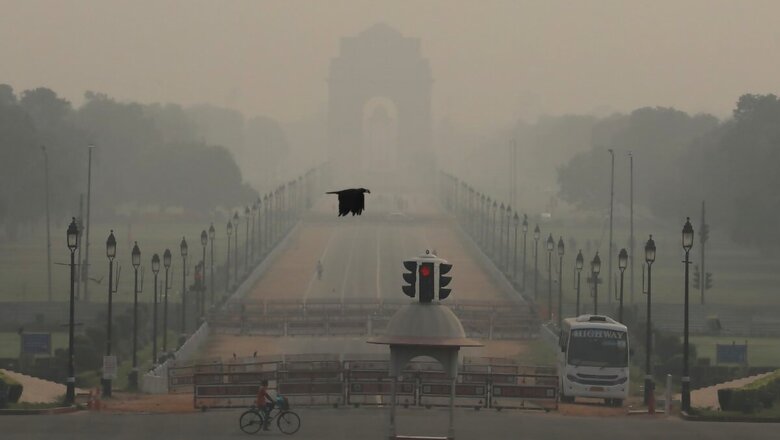
views
In March 1959—when the National Museum that he decreed be built by demolishing a smaller one housing Sir Aurel Stein’s central Asian antiquities on what is now Janpath was still incomplete—Prime Minister Jawaharlal Nehru began his address to the august gathering at New Delhi’s Lalit Kala Akademi’s seminar on architecture with these telling words:
“Mr. Chairman and friends, I have come here for a brief while this morning just to wish those people attending this seminar and specially our younger architects, success in their talks here, meaning thereby a new fermentation taking place in the minds of this generation leading to more suitable types of architecture which fit in with conditions today and yet are things of beauty.
Mr. Humayun Kabir [then cultural affairs minister] referred to the great temples of the South and the Taj Mahal. Well, they are beautiful. Some of the temples of the South, however, repel me in spite of their beauty. I just can’t stand them. Why? I do not know. I cannot explain that, but they are oppressive, they suppress my spirit. They do not allow me to rise, they keep me down. The dark corridors—I like the sun and air and not dark corridors.
However, architecture today can hardly be thought of, well, broadly speaking, in terms of the Taj Mahal. The Taj Mahal is, of course, one of the most beautiful things anywhere and it is a delight to the eye and to the spirit to see it. It represented, as all architecture represents to a large extent, the age in which it grew. You cannot isolate architecture from the age, from the social conditions, from the thinking, from the objectives and ideals of that particular age…”
Three points in his opening remarks have a direct bearing on the current sound and fury over the Central Vista redevelopment project. The first, of course, is that Nehru hated south Indian temple architecture but loved the Taj Mahal. Second, he agreed architecture must move with the times and be representative of India’s changing social conditions. And third, he professed a distinct preference for sunlight and air over dark corridors.
That seminar’s participants eventually decided that modernist free expression should prevail over a state-driven revivalist style. But what are the notable public buildings commissioned and constructed under Nehru’s watch? First, the Ashok Hotel and Vigyan Bhavan, then Krishi and Udyog Bhavans and National Museum, all of them ‘revivalist’ but definitely mindful of Nehru’s disdain for temple architecture and predilection for Mughal style.
ALSO READ | What to do about Concerned Retired Top Bureaucrats Writing Letters on Central Vista?
The way the first two buildings came up is also germane to the current controversy about the “haste” with which the Central Vista project was pushed through, without “dialogue” with “all stakeholders”. It is well known that at the UNESCO summit in Paris in 1955, Nehru impulsively announced India would like to host the next meet in New Delhi in 1956. The offer was accepted.
As New Delhi had neither a large convention centre nor enough hotels, his rash decision meant spaces had to be found, architects appointed, and construction begun pronto. While the faux Mughal-Rajput pile that is now Ashok Hotel came up not far from Nehru’s residence at Teen Murti House, the axe fell on a grand Lutyens bungalow on No 4 King Edward Road (now Maulana Abul Kalam Azad Road) for the ersatz Buddhist Vigyan Bhavan.
Architects were also found double quick: E.B. Doctor, a professor of architecture from Mumbai, was named to design Ashok Hotel and the Central Public Works Department’s R.A. Gehlote was selected for Vigyan Bhawan. And although Nehru favoured the vehemently ‘modernist’ architectural style of his young US-returned Gujarati protégé Mansinh Rana, he nevertheless approved a Buddhist-‘modern’ mishmash for Vigyan Bhawan.
Incidentally, Maulana Azad lived at No. 6 King Edward Road till he passed away in 1958, while No. 2—which was (then) Vice President S. Radhakrishnan’s residence—made way for the National Museum, now itself heading for demolition. The Vice President’s current residence is No. 6, the only building of Lutyens’ era left on the road. Sadly, it is to be razed too, and will thus be the Central Vista project’s only ‘heritage’ casualty.
Those hyperventilating at the sheer pace of progress of the Central Vista project, from announcement in 2019 to start of the new Parliament’s construction in December 2020, may be shocked to learn that Ashok Hotel and Vigyan Bhavan were completed in just 15 months. With no speedy communication back then—no social media or email—the probability of wider consultations with any or all ‘stakeholders’ beforehand was obviously nil.
Did the ideological precursors to those asserting the Central Vista redevelopment is just a vanity project of the current prime minister, criticise India’s first prime minister for grandly building a huge conference hall and mammoth hotel just to accommodate foreign delegates at a time when India presumably needed only more hospitals and other ‘temples of modern India’? They did not, otherwise these two buildings would never have come up in time for the UNESCO conference.
Coming back to Nehru’s frank revelation of his pet hates and loves to architects in 1959, it is hard to imagine that the dim, dank and smelly rabbit warrens that most government offices are now would have found favour with him. Other excerpts of that same speech also reveal more about Nehru’s attitude to modern architecture in India, and could well be interpreted as almost prophesying the redevelopment of the Central Vista:
“….architecture depends certainly on climate; it depends on functions: the functions the people living in those buildings, or looking at them, have to perform. It depends on the state of technological growth, that is to say, on the material we use and obviously on the state of scientific and technological growth and on other factors too…
… But even the PWD can do two things: one is, of course, to revise the antiquated rules and bring them up-to-date. I use the word ‘antiquated’ in the sense that they were drawn up when they dealt with not exactly the materials we use today or, even if they did, they dealt with them in a different sense. Secondly, it is not necessary always to aim at putting up, well, a normal building to last a hundred years. It is not necessary at all. In fact, it will be better for them to be knocked down and after a few years [and] a better one to be put up…”
That Nehru believed in the ‘knock down and build anew’ philosophy is amply demonstrated by his willingness to set the precedent to demolish the Lutyens’ era bungalows flanking Rajpath starting with Vigyan Bhavan. That set the trend of those houses (and their trees) being razed to make way for the terrible twins Udyog & Krishi, Shastri & Nirman, Rail & Vayu—that became the template for badly planned and worse maintained government ‘bhavans’.
In 2013, INTACH submitted a ‘tentative’ list to the Delhi Urban Arts Commission of post-Independence buildings that should be notified as ‘modern heritage’. Only ONE building on Rajpath among those being mourned now was included in the list: Vigyan Bhavan. Not even the National Museum or Indira Gandhi National Centre for the Arts. Clearly the experts and stakeholders who compiled it did not consider the rest of those edifices ‘iconic’ till 2019!
No information is available (at least in the public domain) about whether any ‘stakeholder’ discourse preceded the construction of any of the government office buildings on Rajpath, in Nehru’s time or later. There was an open competition only for the IGNCA, which was won by a non-Indian. All purely government ‘bhavans’ were designed, built and maintained by the CPWD, whose track record on such matters is a perennial subject for debate!
Would those now protesting that an “outsider” from Gujarat (never mind that the architect of National Museum, Supreme Court and Krishi and Udyog Bhavans was also a Gujarati!) won the contract to design the new Parliament and government office buildings on the Central Vista beating several others, have preferred the dazzling in-house talents of the CPWD for this task again? With some of these vocal worthies roped in as expert advisors, perhaps?
Read all the Latest News, Breaking News and Coronavirus News here.

















Comments
0 comment